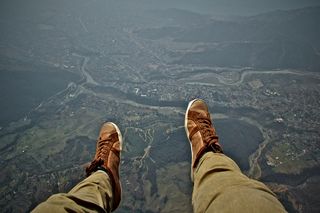Fear
Why We're Afraid of Heights
... and what to do when flying feels like falling.
Posted February 19, 2016 Reviewed by Ekua Hagan

When up high and enclosed, falling from the high place is impossible. Even so, fear of being up high can develop. In an airliner, we may fear that the plane will fall. Or we may feel too disconnected from the earth. We feel fear when our most basic means of controlling feelings—using our own two feet to approach what interests us and to back away from what frightens us—is lost.
What about fear of high places when not enclosed? In some cases, it involves proprioception, the brain’s unconscious sense of body-in-space orientation. Five systems help us sense where we are in relation to the environment and objects in the environment, moving or static:
- Inner ear—senses the position of the head, the pull of gravity, acceleration
- Eyes—distance to objects, placement of objects, size of the environment
- Touch—various sites on the body provide a sense of balance
- Smell—distance and direction of objects
- Hearing—distance and direction of objects
If any of these systems are not informing us, it lessens our sense of body-in-space and of our body in relation to objects. Diminished orientation, particularly in an insecure environment, may cause us to feel disturbed.
Vision tends to be our primary sense of spatial and object orientation. At times, it is the primary way we maintain our balance. To help orient us, the eyes need something within 30 feet to use as a reference. To see things that are close, the eyes slightly cross. To see things farther away, they cross less. We sense the amount of crossing unconsciously. When seeing an object, if we start to go off balance toward it, we cross a bit more. We sense that and automatically correct. If we start to go off balance away from it, we cross a bit less.
When looking out from the top of a building, there is nothing within 30 feet (the eyes don't cross or uncross enough past 30 feet for us to sense it). But you still need to balance. Up high, the need to balance may be urgent. Your eyes try to help you keep your balance. They search out, find nothing, and then search closer, find nothing; search out, find nothing; search in, find nothing. This can cause you to feel dizzy and even more disoriented. Just when you need your balance most, your eyes run into difficulty. As your eyes search in and out, they throw your balance off and cause fear of falling or being out of control.
Another source of the fear of heights may be dreams of flying, as in movies like Peter Pan, Mary Poppins, and The Flying Nun. These characters have delighted us in stories of flying, not with a plane, but just bodily. Captain Truman Cummings, who started the first course on fear of flying at Pan Am in 1975, said that most pilots have fear of heights—not when enclosed in the cockpit, but when unenclosed.
He believed pilots have such dreams more than most people. Thus, when up high and unenclosed, a past dream of floating delightfully across the sky emerges. As it does, the wish to follow the dream sets off alarms. To some degree, there is a desire to leap out there and fly bodily. What if you had acted on the desire? "How close was I to doing that? Am I, or am I not, in control?"
That fantasy—when separated from reality—is delightful. But recognition of the urge to do it is distressing. If you had obeyed the urge, the result would have been fatal. This kind of "near miss" with death may lead to fear of high open spaces.
Similarly, a person who is subject to panic attacks knows that they can stop a panic attack by escape. If the person habitually escapes when panic starts, being in an open high place that offers escape by jumping can cause anxiety. Again, the question of "Am I in control?" arises.
Being up high where there is an expansive vista can trigger high anxiety or panic; there are so many things in view. A healthy executive function prioritizes what a person focuses on, moment by moment. But when the executive function is weak, if the person is unable to limit their focus, this overwhelms cognition. When cognition is overwhelmed, there is a lessening of one's sense of self via loss of orientation in person, place, and time. Loss of sense of self can be terrifying.
Fear of heights when unenclosed may be nothing more than the result of dreams of flying like Mary Poppins. It may be the result of completely normal reduced proprioception due to nothing within 30 feet.
What about the fear of flying?
These fears mean nothing when it comes to fear of flying. What does count when flying is knowing that there is something holding the plane up. To the emotional right brain, which uses visual logic, seeing is believing. If you see nothing holding the plane up, it seems there is no way for the plane to stay up. We need to satisfy the left brain intellectually by understanding Bernoulli's principle. We also need to satisfy the right brain emotionally by picturing something holding the plane up. For that, I offer a video of "The Jell-O Exercise." If, however, situations easily or frequently challenge one's sense of self, a therapist may be able to provide effective help.


